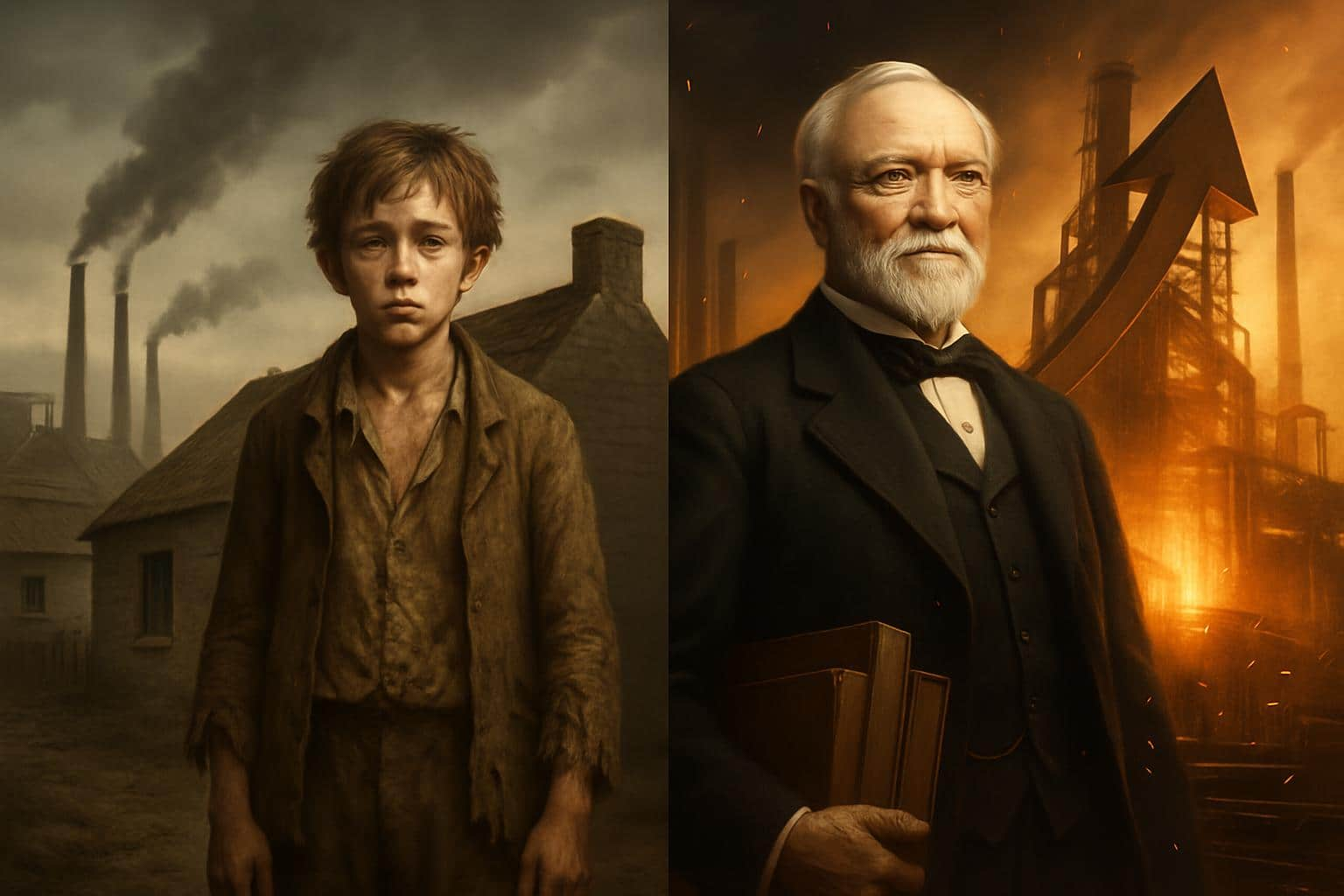Table of contents
- Early Life & Struggles: Forged in the Fires of Poverty
- Turning Points: The Making of an American Success Story
- Breakthrough Success: Building the Steel Empire
- Key Business Moves: The Decisions That Defined an Empire
- Legacy & Lessons Learned: The Gospel of Wealth and Lasting Impact
- The Transformation from Industrialist to Philanthropist
- The Gospel of Wealth: A Revolutionary Philosophy
- The Library Legacy: Knowledge for All
- Educational Philanthropy: Building Institutions for Learning
- International Peace and Understanding
- The Carnegie Corporation: Institutionalizing Philanthropy
- Lessons from Carnegie’s Success: Timeless Principles
- The Contradictions of a Complex Legacy
- The Enduring Impact: Carnegie’s World Today
- Lessons for Modern Entrepreneurs
- The Ultimate Rags-to-Riches Story
The remarkable story of how a poor Scottish immigrant boy Andrew Carnegie became the richest man in the world
In the annals of American success stories, few tales are as compelling as that of Andrew Carnegie. Born into crushing poverty in Scotland, this remarkable man would rise to become the richest person in the world, revolutionize an entire industry, and ultimately give away nearly his entire fortune. Andrew Carnegie’s journey from a desperate immigrant family’s struggle to the pinnacle of American capitalism represents one of history’s most extraordinary rags-to-riches transformations.
Andrew Carnegie’s story is not just about accumulating wealth—it’s about the power of determination, the importance of education, and the responsibility that comes with success. His life embodied both the promise and the contradictions of the American Dream, showing how one person could simultaneously champion workers’ rights while crushing their unions, advocate for democracy while wielding autocratic power, and preach about social responsibility while profiting from dangerous working conditions.
This is the story of Andrew Carnegie, a man whose legacy continues to shape our world today through the thousands of libraries that bear his name and the philanthropic principles he established. It’s a tale that begins in the poverty-stricken streets of 19th-century Scotland and culminates in the gleaming steel mills of industrial America.
Early Life & Struggles: Forged in the Fires of Poverty
The Weaver’s Son in a Changing World

Andrew Carnegie was born on November 25, 1835, in Dunfermline, Scotland, once a proud medieval capital of the country. His father, William Carnegie, was a handloom weaver who made fine linen, a family trade for many generations. His mother, Margaret Carnegie, was a strong-willed woman who would prove instrumental in shaping her son’s destiny.
Dunfermline was well known for producing Britain’s finest damask linens, and its weavers took deep pride in their work.
Families like the Carnegies lived modest but stable lives, built around this respected and time-honored craft tradition. Andrew grew up in a small stone cottage, surrounded by the steady clatter of looms and a close-knit community.
But change was coming fast—Britain’s Industrial Revolution was replacing traditional crafts with steam-powered machines and factory systems. By the 1840s, Dunfermline’s royal castle stood in ruins, a symbol of the town’s fading importance and lost prosperity. The linen industry collapsed, leaving skilled artisans like the Carnegies struggling to survive in a rapidly modernizing world.
The Crushing Weight of Industrial Change
The arrival of steam-powered looms in Dunfermline in 1847 marked the end of an era. Hundreds of skilled hand loom weavers, including William Carnegie, suddenly found themselves expendable. Machines could produce in hours what had taken skilled craftsmen days to create, and they could do it far more cheaply.
The impact on the Carnegie family was devastating. William Carnegie, once a proud and prosperous weaver, was reduced to begging for work. The man who had provided for his family with dignity and skill now faced the humiliation of unemployment and poverty. Young Andrew witnessed his father’s desperation firsthand, an experience that would burn itself into his memory forever.
“I began to learn what poverty meant. It was burnt into my heart then that my father had to beg for work. And then and there came the resolve that I would cure that when I got to be a man.”
Margaret Carnegie, recognizing that her family’s survival was at stake, took action. She opened a small grocery shop and began mending shoes to bring in whatever income she could. The proud weaver’s wife had become the family’s primary breadwinner, a role reversal that spoke to both her strength and the desperate circumstances they faced.
Political Awakening and the Chartist Movement of Andrew Carnegie

The Carnegie family’s struggles were not unique. Across Dunfermline and throughout Britain, working families were grappling with the harsh realities of industrial change. Many, including the Carnegies, found hope in a political movement called Chartism—a popular uprising of the British working class that demanded voting rights and representation in Parliament.
Andrew’s father William and his uncle Tom Morrison became leaders of the Chartist movement in Dunfermline. They believed that by giving working people the vote and the right to run for Parliament, they could seize control of government from the landed gentry and create a more just society. Tom Morrison organized a national general strike in 1842, while William published letters in radical magazines and served as president of one of the local weavers’ societies.
Young Andrew absorbed these political discussions and witnessed firsthand the power of organized action. The Chartist meetings in their home exposed him to ideas about democracy, workers’ rights, and social justice that would influence his thinking throughout his life. However, the movement ultimately failed when Parliament rejected the Chartists’ demands for the final time in 1848.
The failure of Chartism left many working families feeling hopeless about their prospects in Britain. For the Carnegies, it became clear that their future lay not in Scotland, but across the Atlantic in America.
The Desperate Decision to Leave Everything Behind
By 1848, the Carnegie family faced a harsh choice: stay in Scotland and endure poverty or seek a new life abroad. Margaret Carnegie, fearing for her family’s future, became the driving force behind the bold decision to leave everything behind. Her sister, living in America for eight years, assured them the country offered better opportunities for working people than Scotland.
The decision to leave was not made lightly. The Carnegies had to leave behind everything familiar—their home, community, and culture—for an uncertain future in a distant land. They auctioned off all their belongings to raise money, letting go of possessions tied to generations of family life. Even after selling everything, they still didn’t have enough money to cover the full cost of the family’s passage.
Desperate, they managed to borrow 20 pounds and secured space on a small sailing ship called the Wiscasset. At the harbor in Glasgow, they joined hundreds of other emigrants in the ship’s hold, packed into tightly squeezed bunks with no privacy and minimal provisions for the 50-day journey ahead.
The voyage was a trial by ordeal. The ship’s crew was undermanned, and passengers were frequently called upon to help with the ship’s operations. Half the passengers lay sick in their bunks, overwhelmed by seasickness and the rolling motion of the sea. The food was miserable, the conditions were cramped, and privacy was nonexistent.
Yet through it all, there was hope. The passengers traded stories about the lives they would build in the New World, sharing dreams of opportunity and prosperity that sustained them through the darkest moments of the journey. For 13-year-old Andrew Carnegie, this voyage represented not just a physical journey, but a transformation from a Scottish weaver’s son to an American immigrant with unlimited possibilities.
Arrival in the Land of Opportunity

When New York finally appeared on the horizon, the Carnegies felt a mix of relief, awe, and growing anticipation. Their ship passed the lush farmland and forests of the Bronx before anchoring at Castle Garden, Manhattan’s immigration point. This was seven years before New York built a formal immigration station and decades before Ellis Island officially opened.
The Carnegies stepped into the chaos and energy of New York, overwhelmed but eager to reach their final destination: Pittsburgh. They took a steamer up the Hudson River to Albany, where competing agents offered transport west via the Erie Canal. Each family member felt urgency, hope, and uncertainty as they continued deeper into the American interior.
The journey continued at a pace of 35 miles per day—slow travel that was far from comfortable. Their “quarters” consisted of a narrow shelf in a hot, unventilated cabin. After Buffalo, they endured three more canal boat trips, arriving in Pittsburgh after three exhausting weeks on the move.
By 1848, Pittsburgh was a booming industrial center already facing severe environmental damage from factories and furnaces. The 1845 downtown fire had left ruins; even new buildings were quickly stained black by thick industrial soot.
Many called the city “hell with the lid off,” describing smoke-filled air and filth that clung to everything.
The Carnegie family settled in a neighborhood called either Barefoot Square or Slab Town, depending on who was describing it. Their house on Rebecca Street was flimsy and dark—a sharp contrast to the solid stone cottage they left in Scotland. Andrew later recalled, “Smoke penetrated everything… if you washed, you were filthy again within the hour.”
Despite the harsh conditions, Pittsburgh represented opportunity. The city’s furnaces and mills symbolized a world roaring toward the future, driven by American ingenuity and technology. For the Carnegie family, it was a place where hard work and determination could lead to success—if they were willing to pay the price.
Turning Points: The Making of an American Success Story
From Bobbin Boy to Telegraph Messenger
The Carnegie family’s arrival in Pittsburgh began Andrew’s journey from Scottish immigrant boy to American success story. At just 13 years old, Andrew confronted the harsh realities of industrial life when his father found work in a cotton factory. Andrew soon joined him, taking his first job in the same building as a bobbin boy for $1.20 per week.
The work was exhausting and repetitive, demanding constant focus as he replaced spools of thread on fast-moving spinning machines. The factory was hot, loud, and filled with dangerous machinery, where accidents were common and conditions were incredibly harsh. For a boy raised in a quiet Scottish cottage, this sudden exposure to factory life was overwhelming and physically draining.
Yet Andrew possessed rare qualities that separated him from others: deep curiosity, ambition, and a fierce desire to rise above poverty. Even in these early days, he demonstrated the qualities that would later make him one of America’s most successful entrepreneurs.
Carnegie’s next opportunity came when he secured a position as a messenger boy in Pittsburgh’s telegraph office. This job paid better than factory work and, more importantly, exposed him to the city’s business community. As he delivered messages throughout Pittsburgh, Carnegie made it his business to memorize the street layout and learn the names and addresses of the important people he served.
This attention to detail would prove invaluable. Carnegie didn’t just deliver messages; he studied the people he served, learning about their businesses and understanding how the city’s economy functioned. He was building a network and gaining knowledge that would serve him throughout his career.
The Power of Self-Education
One of the most significant turning points in Carnegie’s early life came through his discovery of the power of education. Despite having left school at a young age, Carnegie was determined to continue learning. He often arranged to deliver messages to the theater at night, staying afterward to watch plays by Shakespeare and other great playwrights. These experiences exposed him to literature and culture that broadened his perspective beyond the industrial world of Pittsburgh.
Even more important was Carnegie’s discovery of a small library that a local benefactor had made available to working boys. This library became Carnegie’s university, a place where he could explore books on history, literature, and business. The impact of this access to knowledge was profound and would later inspire Carnegie’s most famous philanthropic endeavor: the funding of public libraries around the world.
“The result of my own study of the question, What is the best gift which can be given to a community? is that a free library occupies the first place, provided the community will accept and maintain it as a public institution.”
Meeting Thomas A. Scott: The Mentor Who Changed Everything
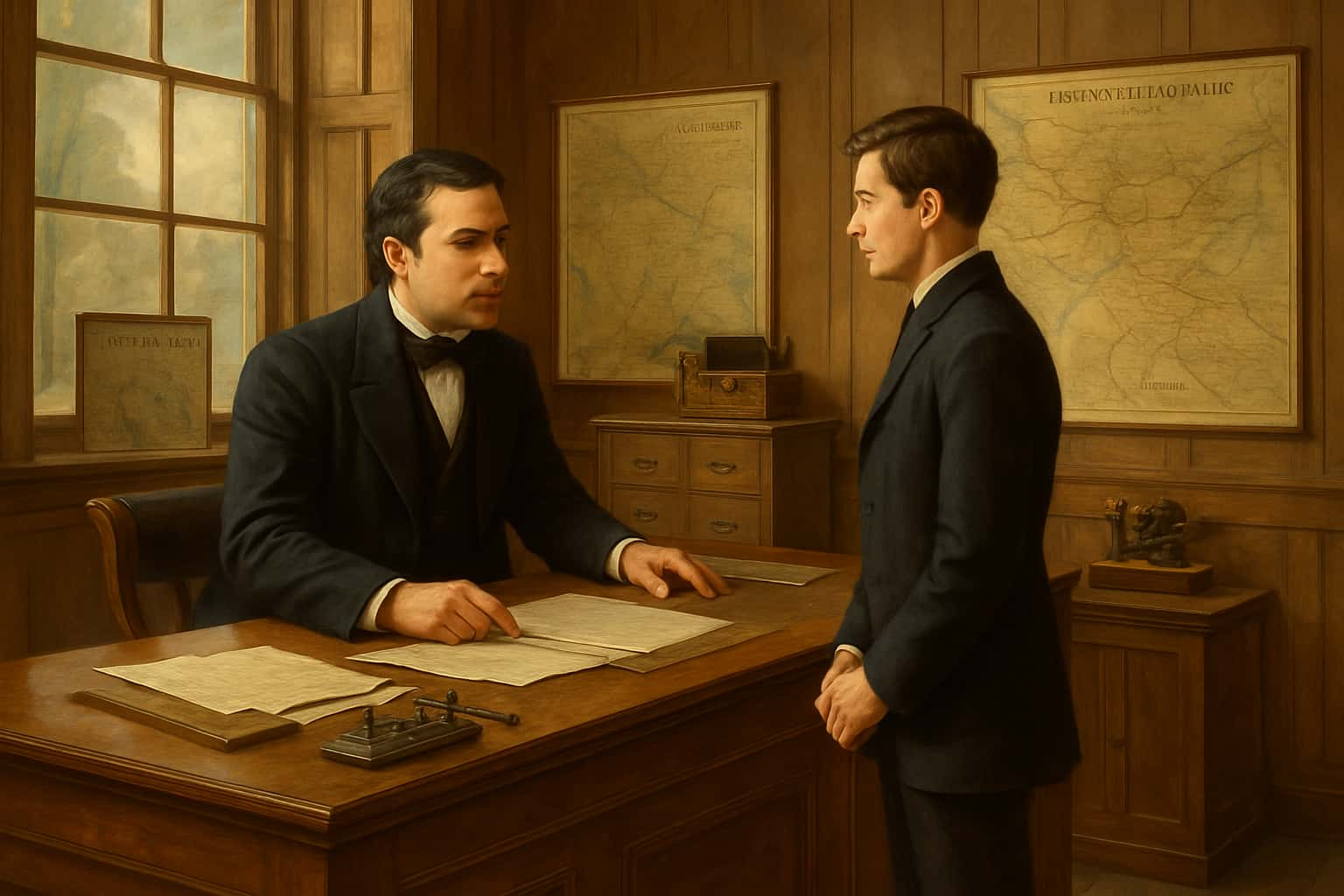
The most crucial turning point in Carnegie’s early career came through his work at the telegraph office, where he met Thomas A. Scott, who was beginning his impressive career at the Pennsylvania Railroad. Scott was immediately impressed by the young worker’s intelligence, dedication, and eagerness to learn. He began referring to Carnegie as “my boy Andy” and took him under his wing as a mentor.
In 1853, Scott hired Carnegie as his private secretary and personal telegrapher at the substantial salary of $35 per month. For Carnegie, this represented an almost unimaginable leap in income and status. “I couldn’t imagine,” Carnegie said many years later, “what I could ever do with so much money.”
But the real value of this position wasn’t the salary—it was the education Carnegie received working alongside one of America’s most talented railroad executives. Scott taught Carnegie about business strategy, financial management, and the art of leadership. More importantly, he showed Carnegie how to think like an entrepreneur, always looking for opportunities to improve efficiency and increase profits.
Andrew Carnegie proved to be an exceptional student. He worked tirelessly to master every aspect of the railroad business, from operations to finance. His dedication and intelligence impressed not only Scott but other executives throughout the Pennsylvania Railroad system. When Scott was promoted, Carnegie was ready to step into increasingly responsible positions.
The Civil War: Opportunity in Crisis
The outbreak of the Civil War in 1861 presented Carnegie with another crucial turning point. Thomas Scott was hired by the federal government to supervise military transportation for the Union Army, and he brought Carnegie with him as his right-hand man. This position gave Carnegie unprecedented access to the highest levels of government and military leadership.
Working in Washington, D.C., Carnegie gained invaluable experience in large-scale logistics and organization. He helped coordinate the movement of troops and supplies across vast distances, managing complex operations under intense pressure. The skills he developed during this period—strategic thinking, crisis management, and the ability to coordinate multiple moving parts—would prove essential in his later business ventures.
The Civil War also exposed Carnegie to the enormous potential of the iron and steel industry. The conflict created unprecedented demand for iron rails, weapons, and other metal products. Carnegie watched as iron companies struggled to meet the military’s needs and began to understand the strategic importance of steel production in America’s industrial future.
First Investments: Learning the Art of Capital
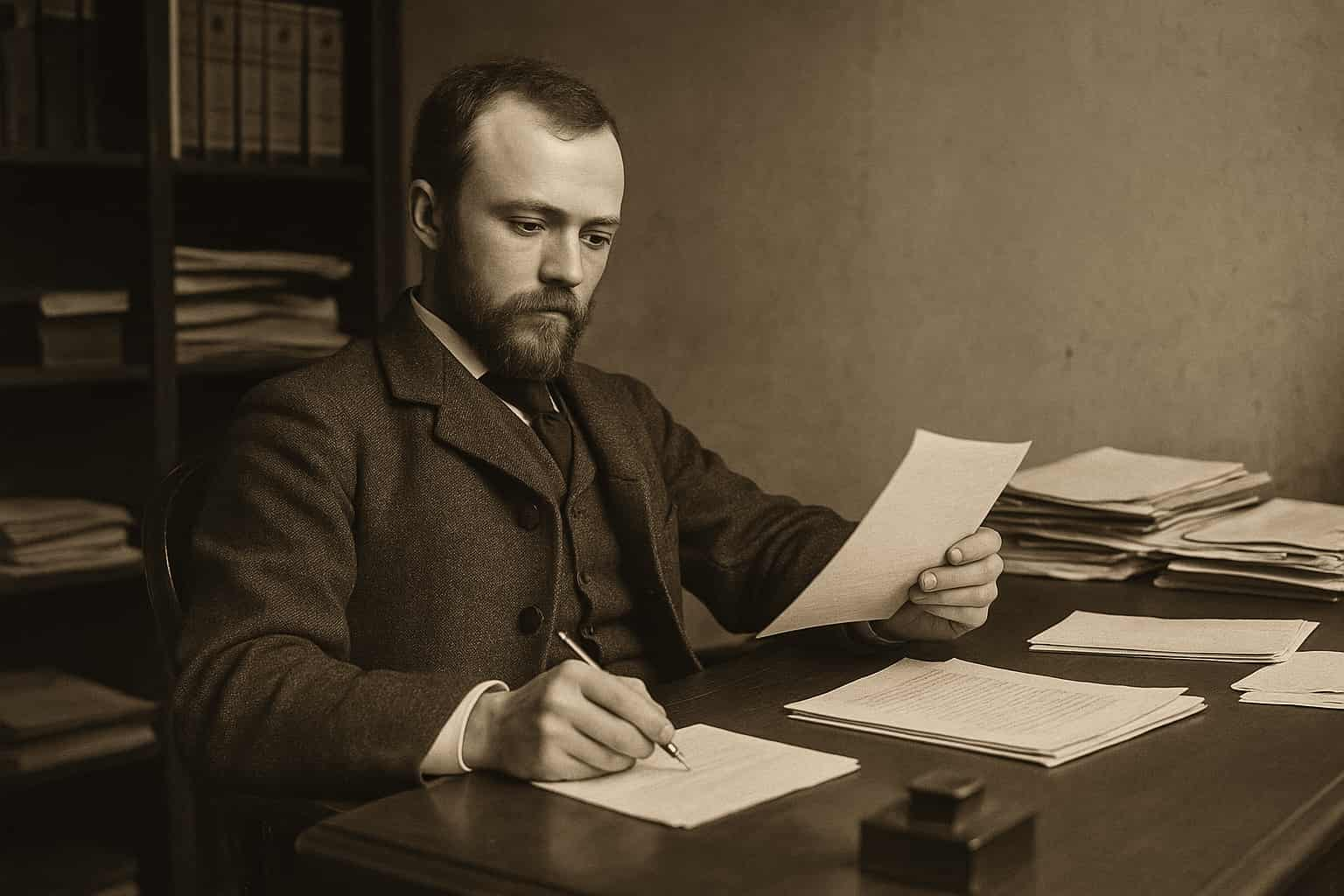
While working for the Pennsylvania Railroad, Carnegie began making his first investments, learning the art of turning money into more money. His initial investment was modest—ten shares of stock in the Adams Express Company—but it marked the beginning of his transformation from wage earner to capitalist.
Carnegie’s approach to investing was methodical and strategic. He studied companies carefully, looking for businesses with strong fundamentals and growth potential. He also learned the importance of diversification, spreading his investments across multiple industries and opportunities.
One of his most successful early investments was in the Woodruff Sleeping Car Company, which manufactured sleeping cars for railroads. Carnegie recognized that as America’s railroad network expanded, there would be enormous demand for comfortable passenger accommodations. His investment in Woodruff proved highly profitable and gave him his first taste of the wealth that could be generated through smart investing.
These early investment successes taught Carnegie several crucial lessons that would guide his later business ventures. He learned the importance of understanding market trends, the value of getting in early on promising technologies, and the power of compound growth. Most importantly, he began to understand that the real money wasn’t in working for wages—it was in owning businesses and investments that could generate passive income.
The Decision to Leave the Railroad
By the mid-1860s, Carnegie had risen to become superintendent of the Pittsburgh Division of the Pennsylvania Railroad, a position of considerable responsibility and prestige. He was earning a good salary and had a secure future with one of America’s most important companies. For most people, this would have been the pinnacle of success.
But Carnegie was not most people. He had bigger dreams and a growing understanding of the opportunities that lay beyond the railroad industry. The Civil War had shown him the enormous potential of the iron and steel business, and he was beginning to see how he could apply the lessons he had learned in the railroad industry to manufacturing.
The decision to leave the Pennsylvania Railroad was not made lightly. Carnegie was giving up security and a steady income to pursue uncertain opportunities in a highly competitive industry. But he had confidence in his abilities and a clear vision of what he wanted to achieve.
“I resigned from the Pennsylvania Railroad in 1865,” Carnegie later wrote, “to give my whole attention to business.” This decision marked the end of Carnegie’s career as an employee and the beginning of his journey as an entrepreneur and industrialist.
Breakthrough Success: Building the Steel Empire
The Iron Bridge That Changed Everything
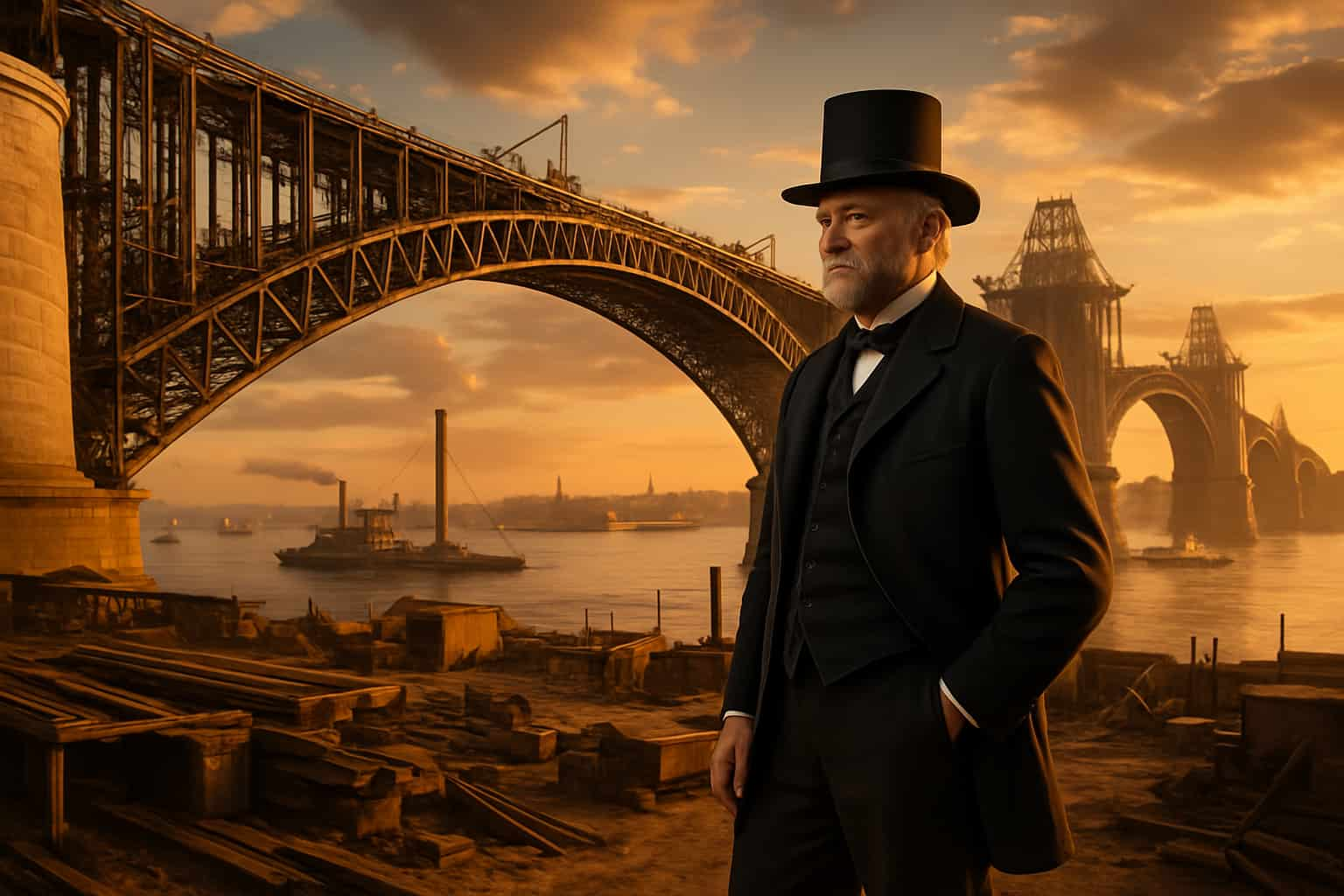
Carnegie’s first major breakthrough came not in steel, but in iron bridges. In the 1860s, America’s rapidly expanding railroad network created enormous demand for bridges that could carry heavy trains across rivers and valleys. Most bridges at the time were made of wood, which was cheap but had serious limitations in terms of strength and durability.
Andrew Carnegie recognized the opportunity and founded the Keystone Bridge Company in 1865, focusing on iron bridge construction. His background in the railroad industry gave him crucial insights into what railroad companies needed, and his connections throughout the industry provided him with customers and credibility.
The company’s breakthrough project came with the construction of the Eads Bridge across the Mississippi River at St. Louis. This massive undertaking required innovative engineering solutions and demonstrated the superiority of iron construction over traditional wooden bridges. The success of this project established Carnegie’s reputation as a serious player in the construction industry and provided him with the capital and credibility he needed for even larger ventures.
Recognizing the Steel Revolution
While iron bridges were profitable, Carnegie was already looking ahead to the next technological revolution: steel. In the 1870s, the development of the Bessemer process made it possible to produce high-quality steel quickly and cheaply. This new technology promised to transform not just bridge construction, but entire industries.
Carnegie studied the Bessemer process intensively, traveling to England to observe the technology firsthand and meeting with its inventors and early adopters. He quickly grasped that steel was not just an improvement over iron—it was a completely different material that would enable new types of construction and manufacturing.
“The age of steel had arrived. I saw that it was destined to revolutionize the world.”
This insight would prove to be one of the most important strategic decisions of his career.
The Edgar Thomson Steel Works: A Revolutionary Approach
In 1872, Andrew Carnegie made a defining decision: he co-founded his first steel company and launched the Edgar Thomson Works. The plant was built near Pittsburgh and designed entirely around the modern Bessemer process, revolutionizing how steel was produced. It marked a bold new direction in American industry, combining innovation, efficiency, and vision in a way few had seen before.
Carnegie’s strategy was revolutionary in its focus on efficiency and cost reduction. While other steel companies were content to operate with traditional methods and accept modest profits, Carnegie was determined to drive down costs and undersell the competition. He invested heavily in the most advanced equipment available and constantly upgraded his facilities as new technologies became available.
The Edgar Thomson Works made its first “blow” in August 1875, showcasing the raw power of modern steel production. Bessemer converters roared as cold air blasted through molten iron, generating intense heat and removing impurities to produce strong, high-quality steel. The process was simple in concept but extraordinary in its effects.
A contemporary observer described the scene as a powerful, colorful eruption of light, flame, and motion from each converter pot. Saffron and sapphire flames roared, streaked with yellow, casting violet shadows and turning the gray rain outside a radiant blue. Sparks shot upward like fireworks, then fell gracefully in arcs, resembling the petals of a massive, glowing industrial flower.
The Relentless Drive for Efficiency
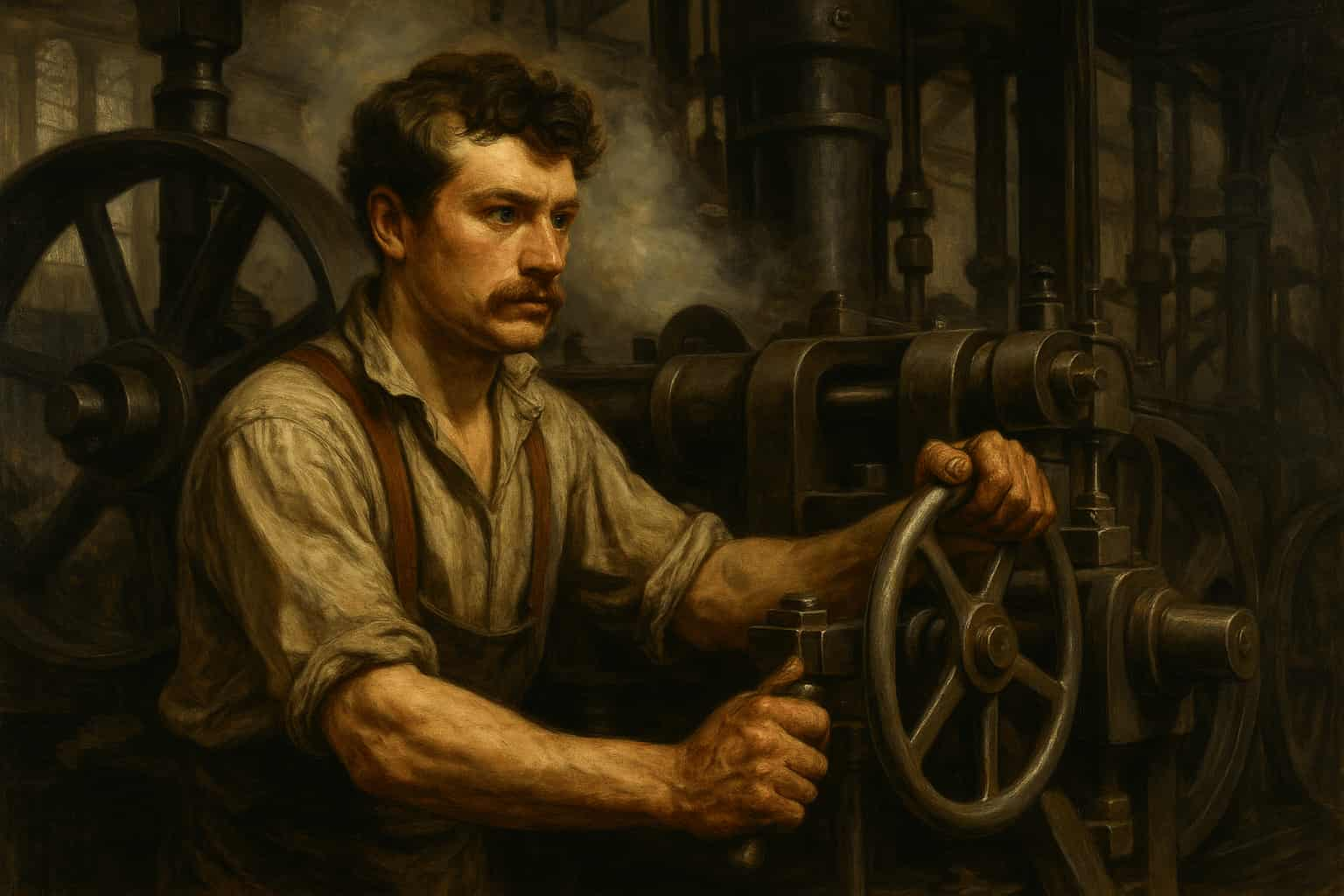
What set Andrew Carnegie apart from his competitors was his obsessive focus on efficiency and cost reduction. He implemented detailed cost accounting systems that tracked every aspect of production, from raw materials to labor costs. This data-driven approach allowed him to identify inefficiencies and continuously improve his operations.
Carnegie’s philosophy was simple: “Watch the costs and the profits will take care of themselves.” He constantly pushed his managers to find ways to reduce costs, whether through improved technology, better organization, or more efficient use of materials. This relentless focus on efficiency made his steel mills the most productive in the world.
The results were dramatic. By 1900, Carnegie’s steel was not only the highest quality available but also the cheapest. This combination of quality and affordability made Carnegie Steel the dominant force in the American steel industry and enabled the construction of the skyscrapers and bridges that would define the modern American landscape.
Vertical Integration: Controlling Every Step
One of Carnegie’s key strategies was vertical integration—controlling every stage of steel production from raw materials to final products. Instead of depending on outside suppliers, he bought iron ore mines, coal fields, coke ovens, and his own transport systems.
This strategy gave Carnegie several crucial advantages. First, it ensured a reliable supply of raw materials at predictable costs. Second, it eliminated the profits that would otherwise go to suppliers, allowing Carnegie to offer lower prices while maintaining higher margins. Third, it gave him complete control over quality at every stage of production.
Carnegie’s vertical integration strategy was so successful that it became the standard model for large-scale industrial operations. By controlling every aspect of production, he could guarantee both quality and cost-effectiveness in ways that his competitors simply couldn’t match.
The Human Cost of Efficiency
While Carnegie’s focus on efficiency made him enormously wealthy, it came at a significant human cost. Working conditions in Carnegie’s steel mills were notoriously harsh and dangerous. Workers faced 12-hour shifts, seven days a week, with only the Fourth of July as a holiday. The work was physically demanding and extremely hazardous.
“Hard! I guess it’s hard. I lost forty pounds the first three months I came into this business. It sweats the life out of a man. I often drink two buckets of water during twelve hours; the sweat drips through my sleeves, and runs down my legs and fills my shoes.”
The demanding conditions took a severe toll on workers’ health and longevity. “You don’t notice any old men here,” observed a Homestead laborer in 1894. “The long hours, the strain, and the sudden changes of temperature use a man up.” Sociologist John A. Fitch called it “old age at forty.”
Despite these harsh conditions, Carnegie’s workers earned relatively modest wages. The average worker in 1890 received about $10 per week, just above the poverty line of $500 per year. It took the combined wages of nearly 4,000 steelworkers to equal Andrew Carnegie’s annual earnings.
Technological Innovation and Continuous Improvement
Carnegie’s success was built not just on the Bessemer process, but on a commitment to continuous technological innovation. As new steel-making technologies emerged, Carnegie was quick to adopt them. By the turn of the century, most of his steel production had shifted to open-hearth furnaces, which could produce even higher quality steel more efficiently than the Bessemer converters.
The open-hearth process used waste gases from molten iron to generate intense heat—nearly 3,000 degrees Fahrenheit. This extreme temperature burned out impurities in the iron, resulting in silvery white steel of exceptional quality. At Carnegie’s Homestead facility, 16 massive open-hearth furnaces operated continuously, each producing 40 tons of steel every six hours.
Carnegie’s willingness to scrap existing equipment and invest in new technology, even when the old equipment was still profitable, kept his mills at the cutting edge of steel production. This philosophy of continuous improvement ensured that Carnegie Steel remained the most efficient and productive steel company in the world.
Key Business Moves: The Decisions That Defined an Empire
The Homestead Acquisition: Expanding the Empire
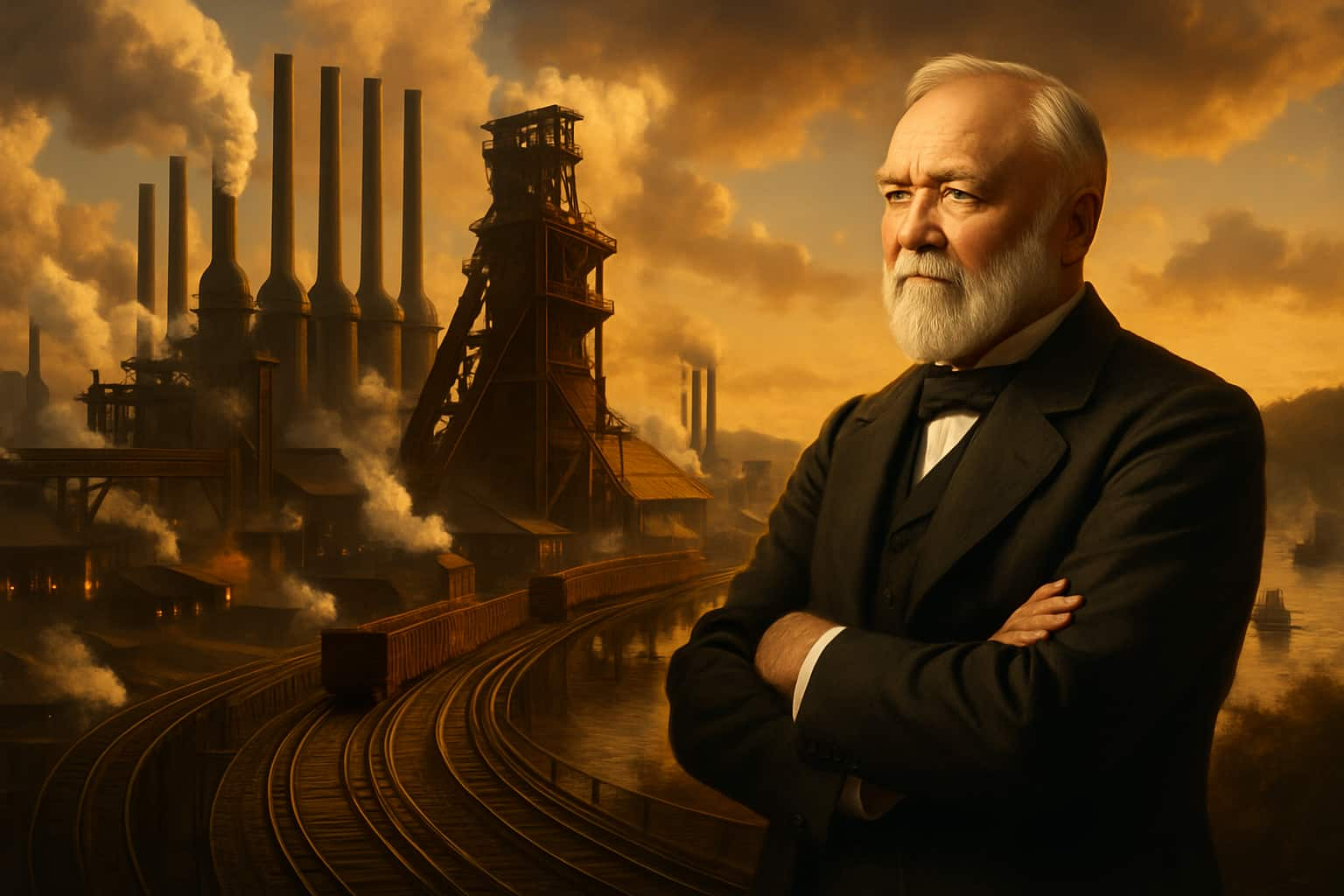
One of Andrew Carnegie’s most significant business moves was the acquisition of the Homestead Steel Works in the early 1880s. This facility, located along the Monongahela River near Pittsburgh, was already one of the largest steel plants in America. By adding Homestead to his growing empire, Carnegie gained not only additional production capacity but also access to some of the most skilled steelworkers in the country.
The Homestead facility was valuable for its advanced open-hearth furnaces and location on the river, enabling efficient transportation access. Carnegie invested heavily in upgrades, adding state-of-the-art equipment and expanding capacity to create one of the world’s top steel plants.
However, the Homestead acquisition would also become the source of Carnegie’s greatest controversy and the event that would forever tarnish his reputation as a benevolent employer.
The Homestead Strike: Andrew Carnegie’s Greatest Crisis
Carnegie’s most defining business moment came in 1892 during the violent labor conflict known as the Homestead Strike.
The strike exposed contradictions in Carnegie’s character—he supported workers publicly but opposed their unions when they threatened his business goals.
The crisis began during an economic downturn that affected the entire steel industry. In early 1892, rolled-steel prices fell from $35 to $22 per ton, pressuring steel companies to reduce production costs. Henry Clay Frick, Carnegie’s general manager at Homestead, aimed to cut wages and crush the powerful Amalgamated Association union.
Despite his public pro-labor stance, Andrew Carnegie supported Frick’s plans behind the scenes. In spring 1892, Carnegie told Frick to produce maximum armor plate before the union’s contract ended in late June. If the union rejected Frick’s terms, Carnegie ordered the plant shut down until workers gave in to company demands. Carnegie assured Frick, “We… approve of anything you do. We are with you to the end.”
In May 1892, Carnegie conveniently traveled to Scotland for his annual vacation, leaving Homestead in Frick’s hands. Although Carnegie would later try to distance himself from the events that followed, his cables to Frick were clear: do whatever it takes to break the union.
The Battle of Homestead: Violence and Tragedy
The conflict escalated rapidly when Frick announced on June 25th that he would no longer negotiate with the union and would only deal with workers individually. Despite the union’s willingness to make concessions on wages, they refused to accept the dissolution of their organization. On June 29, Frick locked out 3,800 workers and began preparing to bring in non-union replacement workers.
The workers responded by seizing control of the mill and sealing off the town from strikebreakers. Although only 750 of the 3,800 workers actually belonged to the union, 3,000 of them voted to support the strike. Frick built a fence three miles long and 12 feet high around the steelworks, adding rifle ports and topping it with barbed wire. Workers nicknamed it “Fort Frick.”
The conflict peaked on July 6, 1892, when 300 detectives arrived by barge on the Monongahela River at 3 a.m. Armed with Winchester rifles, the Pinkertons were ordered to protect non-union workers Frick intended to bring into the Homestead plant.
Thousands of strikers and their sympathizers met the Pinkertons at the riverbank, armed and ready for battle. When the Pinkertons attempted to come ashore, a fierce firefight erupted that lasted for 12 hours. Workers used everything from ancient muzzle loaders to a 20-pound cannon in their battle against the private army.
The scene was chaotic and terrifying. Workers sent flaming freight cars toward the barges, threw dynamite to try to sink the boats, and pumped oil into the river in an attempt to set it on fire. The Pinkertons, trapped on their barges, cowered below deck as bullets flew overhead.
“The noise that they made on shore was awful, and it made us shake in our boots. We were penned in like rats and we went at the fighting like desperate wild men…. All of our men were under the beds and bunks, crying and trembling.”
By the end of the day, nearly a dozen people were dead and many more were wounded. The Pinkertons finally surrendered at 5 p.m., but their ordeal was far from over. As they attempted to leave the barges, angry workers attacked them, beating many severely before they could escape.
The Aftermath: Victory at a Terrible Cost
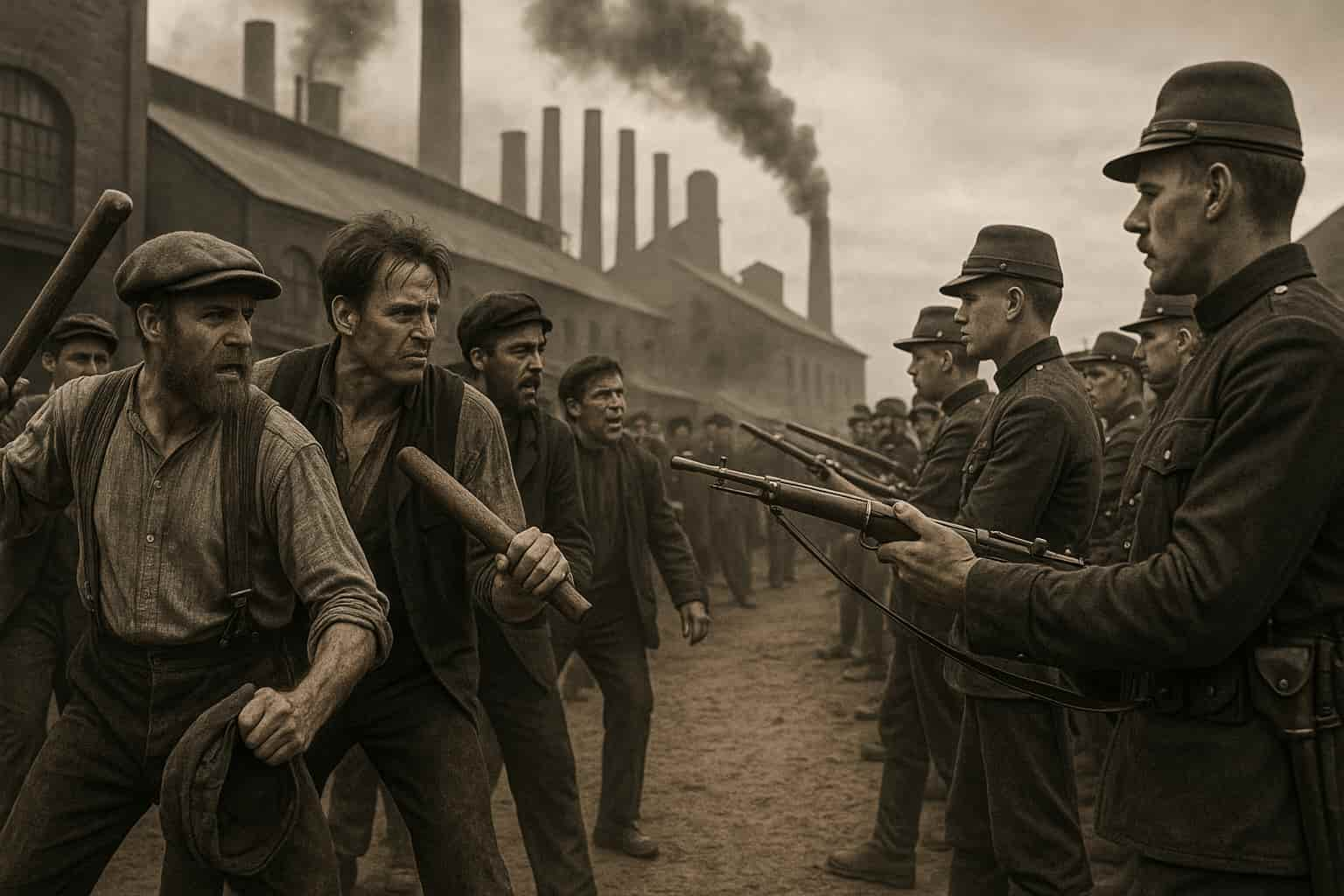
The Pennsylvania state militia eventually arrived to restore order, and Frick succeeded in reopening the plant with non-union workers. The strike ultimately failed, and the Amalgamated Association of Iron and Steel Workers was effectively destroyed. Carnegie had achieved his goal of breaking the union, but at an enormous cost to his reputation and legacy.
The Homestead Strike forever tarnished Andrew Carnegie’s image as a benevolent employer and champion of workers’ rights. The violent confrontation revealed the fundamental contradiction between his public statements supporting labor and his private actions to crush unions when they threatened his profits.
Carnegie later claimed that he had been unaware of Frick’s plans and would have handled the situation differently if he had been present. However, his own correspondence with Frick clearly showed that he had approved and encouraged the aggressive anti-union strategy.
The strike also had broader implications for the American labor movement. The defeat of the powerful Amalgamated Association sent a message to workers throughout the country that even the strongest unions could be broken by determined employers willing to use violence. It would be decades before steelworkers would again achieve significant union representation.
The Sale to J.P. Morgan: The Deal of the Century
The culmination of Carnegie’s business career came in 1901 with his sale of Carnegie Steel to J.P. Morgan, the most powerful banker in America. This transaction, worth $480 million, was the largest business deal in American history up to that time and made Carnegie the richest man in the world.
The negotiations began when Morgan approached Carnegie about selling his steel company. Morgan was planning to create the world’s first billion-dollar corporation by merging Carnegie Steel with nine other steel companies to form United States Steel Corporation. For this plan to succeed, he needed Carnegie’s cooperation.
Carnegie initially seemed reluctant to sell, but he was also approaching retirement age and had long spoken of his desire to devote his later years to philanthropy. When Morgan asked Carnegie to name his price, Carnegie wrote a figure on a piece of paper: $480 million.
Morgan looked at the number and said simply, “I accept.” There was no negotiation, no haggling over terms. The deal was done with a handshake between two of the most powerful men in America.
The sale made Andrew Carnegie the world’s richest man, with a fortune worth hundreds of billions in today’s money. More importantly, it freed him from business duties and let him pursue what he saw as his true purpose: philanthropy.
Strategic Innovations That Changed Industry
Throughout his career, Carnegie introduced several strategic innovations that transformed not only his own company but the entire steel industry. His focus on vertical integration—controlling every step of production from raw materials to finished products—became the standard model for large-scale industrial operations.
Carnegie was also a pioneer in the use of detailed cost accounting and performance measurement. He implemented systems that tracked every aspect of production, allowing him to identify inefficiencies and continuously improve operations. This data-driven approach to management was revolutionary for its time and became a model for modern industrial management.
Perhaps most importantly, Carnegie demonstrated the power of continuous technological innovation. Carnegie often scrapped profitable equipment to invest in new technology, keeping his companies ahead in steel production innovation. His constant improvement strategy made Carnegie Steel the world’s most efficient and productive steel company throughout his entire career.
Legacy & Lessons Learned: The Gospel of Wealth and Lasting Impact
The Transformation from Industrialist to Philanthropist
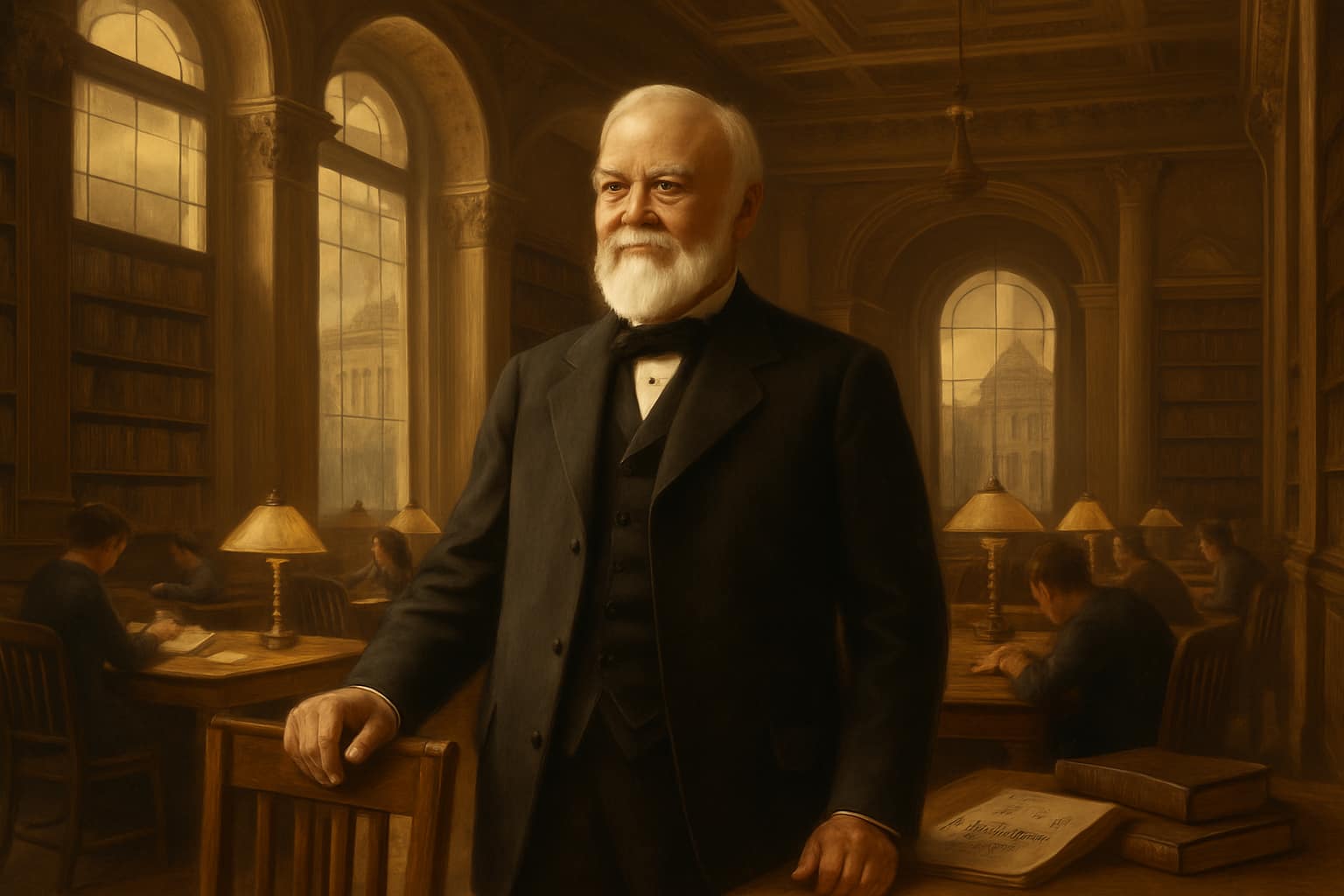
After selling Carnegie Steel to J.P. In 1901, after selling to Morgan, Andrew Carnegie began what he saw as life’s most important phase: giving away wealth. At 66, he was the world’s richest man, yet firmly believed great wealth came with an obligation to help others.
Carnegie’s approach to philanthropy was not casual or haphazard. He had been thinking about the responsibilities of wealth for decades and had developed a comprehensive philosophy that he outlined in his famous 1889 essay, “The Gospel of Wealth.” This document would become one of the most influential pieces of writing on philanthropy in American history.
“The man who dies rich dies disgraced.”
Carnegie expressed his belief that wealthy individuals had a moral obligation to use their fortunes for the benefit of society. He argued that the rich were merely trustees of their wealth, responsible for using it in ways that would help others help themselves.
The Gospel of Wealth: A Revolutionary Philosophy
Andrew Carnegie’s “Gospel of Wealth” outlined a revolutionary approach to philanthropy that emphasized education, self-improvement, and the creation of opportunities rather than simple charity. He believed that giving money directly to the poor was often counterproductive, as it could create dependency rather than self-reliance.
Instead, Carnegie advocated for what he called “scientific philanthropy”—carefully planned giving that would provide people with the tools and opportunities they needed to improve their own lives. This philosophy led him to focus on libraries, universities, and other educational institutions that could have lasting impact on communities.
“The best means of benefiting the community is to place within its reach the ladders upon which the aspiring can rise.”
This approach reflected his own experience as a self-made man who had benefited enormously from access to books and education during his youth in Pittsburgh.
The Library Legacy: Knowledge for All
Carnegie’s most famous and enduring philanthropic achievement was his funding of public libraries around the world. Between 1883 and 1929, Carnegie and the Carnegie Corporation funded the construction of 2,509 libraries in English-speaking countries, including 1,681 public library buildings in 1,412 communities across the United States.
Carnegie’s inspiration came from his youth in Pittsburgh, where a small library had opened his mind to new knowledge. He never forgot that life-changing experience and wanted to give other young people the same chance to learn and grow.
Carnegie’s approach to library funding was systematic and strategic. He would provide the money to build the library, but only if the community agreed to provide the land and commit to ongoing funding for operations and maintenance. This requirement ensured that communities had a genuine commitment to their libraries and would value them as permanent institutions.
The impact of Carnegie’s library program was enormous. In many small American towns, the Carnegie library was the grandest building—a powerful symbol of education and civic pride. These libraries gave free access to books and learning, offering opportunities to people who might never afford them otherwise.
Educational Philanthropy: Building Institutions for Learning
Beyond libraries, Andrew Carnegie invested heavily in higher education and research institutions. He founded Carnegie Mellon University in Pittsburgh, established the Carnegie Institution for Science in Washington, D.C., and provided substantial funding for numerous other educational institutions.
Carnegie’s approach to educational philanthropy reflected his belief in the power of knowledge and innovation to improve society. He was particularly interested in supporting technical education and scientific research, recognizing that these fields would be crucial to America’s continued economic development.
The Carnegie Foundation for the Advancement of Teaching, established in 1905, was another important educational initiative. This organization worked to improve teaching standards and provide retirement benefits for college professors, helping to professionalize higher education in America.
International Peace and Understanding
In his later years, Carnegie became increasingly concerned with the issue of international peace. He believed that war was not only morally wrong but also economically wasteful, diverting resources that could be used for productive purposes.
Carnegie established the Carnegie Endowment for International Peace in 1910 with a $10 million endowment, making it one of the first major foundations dedicated to promoting peace and international understanding. He also funded the construction of the Peace Palace in The Hague, which housed the International Court of Justice.
Carnegie’s peace efforts showed his belief that reason and international law could replace war in settling global conflicts. Though peace didn’t come in his lifetime, the institutions he founded kept working toward that vision after his death.
The Carnegie Corporation: Institutionalizing Philanthropy
Knowing he couldn’t manage all his giving alone, Carnegie founded the Carnegie Corporation of New York in 1911. The foundation’s mission was to “promote the advancement and diffusion of knowledge and understanding” in the U.S. and Commonwealth.
The Carnegie Corporation represented an innovative approach to philanthropy, creating a permanent institution that could continue Carnegie’s work long after his death. This model of foundation-based philanthropy would be adopted by many other wealthy individuals, including John D. Rockefeller and later Bill Gates and Warren Buffett.
Lessons from Carnegie’s Success: Timeless Principles
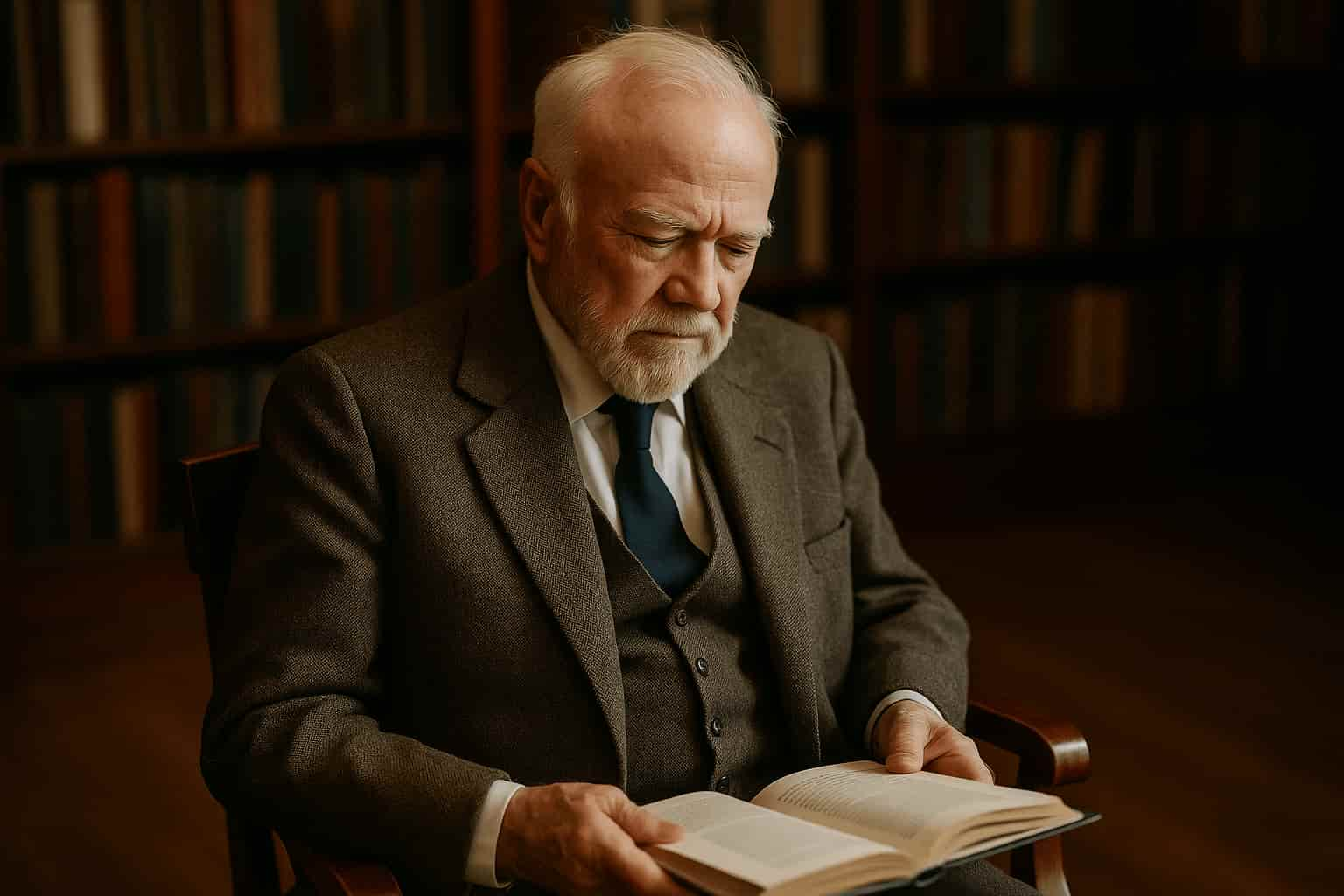
Andrew Carnegie’s extraordinary journey from poverty to wealth offers several timeless lessons for aspiring entrepreneurs and business leaders:
The Power of Education and Self-Improvement: Carnegie was a lifelong learner, always eager to grow his knowledge and abilities. His success came not only from hard work, but from mastering complex ideas and applying them wisely in business.
The Importance of Mentorship: Carnegie’s relationship with Thomas A. Scott was crucial to his early success. Scott not only provided Carnegie with opportunities but also taught him how to think strategically about business. Carnegie later became a mentor to others, understanding the importance of passing on knowledge and experience.
Focus on Efficiency and Innovation: Carnegie’s obsessive focus on reducing costs and improving efficiency was a key factor in his success. He understood that in competitive industries, the most efficient producers would ultimately prevail.
The Value of Strategic Thinking: Carnegie was always thinking several steps ahead, anticipating market trends and positioning his companies to take advantage of future opportunities. His early recognition of steel’s potential and his decision to invest heavily in the Bessemer process exemplified this strategic approach.
The Responsibility of Success: Perhaps most importantly, Carnegie understood that great success brings with it great responsibility. His commitment to philanthropy reflected his belief that those who benefit from society’s opportunities have an obligation to give back.
The Contradictions of a Complex Legacy
Carnegie’s legacy is not without its contradictions and controversies. While he preached about the rights of workers and the importance of democracy, he also crushed unions and maintained autocratic control over his businesses. The Homestead Strike remains a dark chapter in his story, showing how his pursuit of efficiency and profit could override his stated concern for workers’ welfare.
These contradictions reflect the broader tensions of the Gilded Age, when rapid industrialization created enormous wealth alongside significant social problems. Carnegie was both a product of his time and a shaper of it, embodying both the promise and the problems of American capitalism.
The Enduring Impact: Carnegie’s World Today
More than a century after Andrew Carnegie’s death in 1919, his impact on American society remains profound and visible. Carnegie libraries continue to serve communities across the country, many of them still operating in the beautiful buildings he funded. Carnegie Mellon University has become one of the world’s leading research institutions, particularly in technology and engineering.
The Carnegie Corporation continues its philanthropic work, having distributed hundreds of millions of dollars for education, international peace, and other causes. The foundation’s current focus on education reform and international development reflects Carnegie’s original vision while adapting to contemporary challenges.
Perhaps most importantly, Carnegie’s model of strategic philanthropy has inspired generations of wealthy individuals to give away their fortunes for the public good. The Giving Pledge, initiated by Bill Gates and Warren Buffett, explicitly draws on Carnegie’s example and philosophy.
Lessons for Modern Entrepreneurs
For today’s entrepreneurs and business leaders, Carnegie’s story offers both inspiration and cautionary lessons. His rise from poverty to wealth demonstrates the continued relevance of the American Dream, while his philanthropic philosophy provides a model for using success to benefit society.
Carnegie’s focus on efficiency, innovation, and strategic thinking remains as relevant today as it was in the 19th century. His understanding of the importance of technology and his willingness to invest in new methods and equipment offer lessons for companies operating in rapidly changing industries.
At the same time, Carnegie’s labor controversies remind us that success should never come at the cost of workers’ rights. Today’s business leaders can learn from his legacy—aiming to build companies that are both profitable and socially responsible.
Like many successful entrepreneurs today, similar to how Elon Musk transformed multiple industries, Carnegie understood the importance of thinking beyond traditional boundaries and constantly pushing for innovation and improvement.
The Ultimate Rags-to-Riches Story
Andrew Carnegie’s journey from a poor Scottish immigrant boy to the richest man in the world represents one of history’s most remarkable rags-to-riches stories. His life demonstrates the power of determination, education, and strategic thinking to overcome even the most challenging circumstances.
But Carnegie’s story is about more than just accumulating wealth. It’s about the responsibility that comes with success and the importance of using one’s advantages to benefit others. His transformation from ruthless industrialist to generous philanthropist shows that it’s possible to change and grow throughout one’s life.
In an age when inequality and the responsibilities of wealth are once again major social issues, Carnegie’s example remains relevant and instructive. His belief that “the man who dies rich dies disgraced” challenges today’s wealthy individuals to think seriously about their obligations to society.
Andrew Carnegie’s legacy reminds us that true success is measured not just by what we accumulate, but by what we contribute. His libraries, universities, and foundations continue to benefit millions of people around the world, ensuring that his impact will be felt for generations to come. In the end, this may be the most important lesson of all: that the greatest riches come not from what we keep, but from what we give away.
This article explores the extraordinary life of Andrew Carnegie, from his humble beginnings in Scotland to his rise as America’s steel king and his transformation into one of history’s greatest philanthropists. His story continues to inspire entrepreneurs and philanthropists around the world, demonstrating that with determination, strategic thinking, and a commitment to giving back, it’s possible to rise from the deepest poverty to make a lasting impact on the world.
- Welcome to The Phoenix Ascent
- From Poverty to Power: The Extraordinary Rags-to-Riches Journey of Oprah Winfrey
- From Dishwasher to Billionaire: The Extraordinary Journey of Shahid Khan
- From Housing Projects to Horse Racing Glory: The Kenny Troutt Story
- Roman Abramovich: From Soviet Orphan to Billionaire Oligarch – The Ultimate Rags to Riches Story
You should listen to our podcast. https://thephoenixascent.com/andrew-carnegie/

